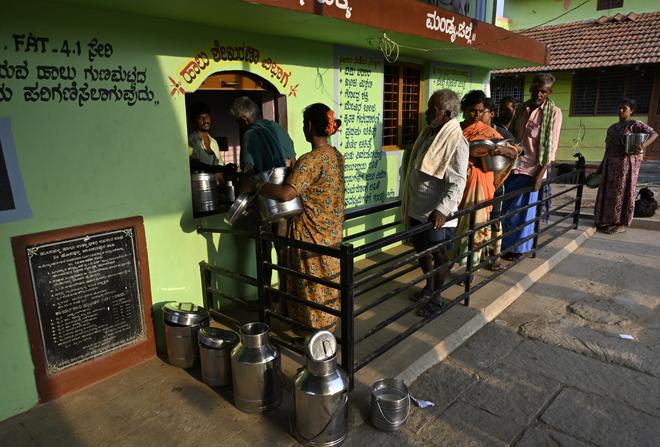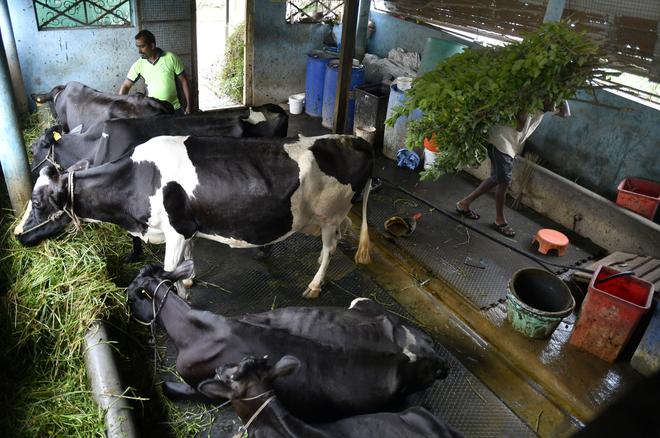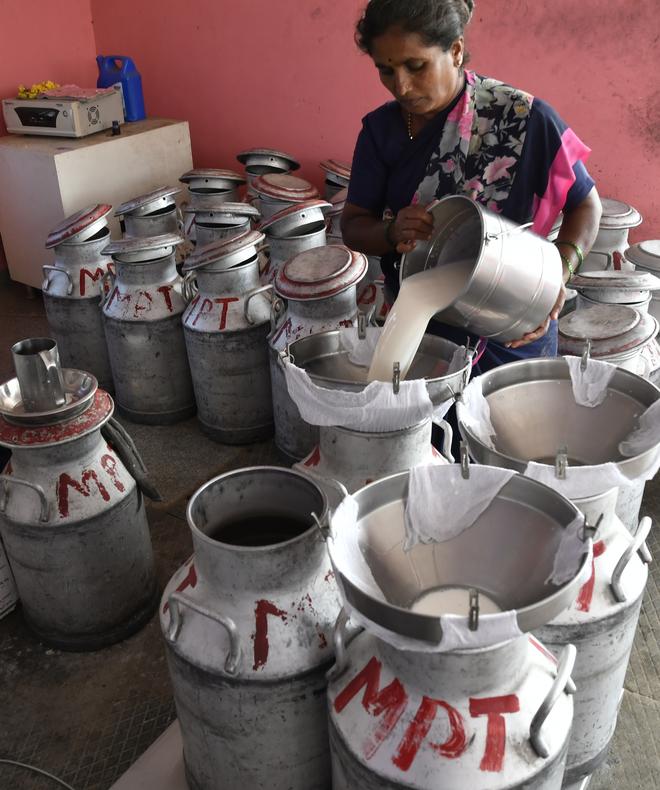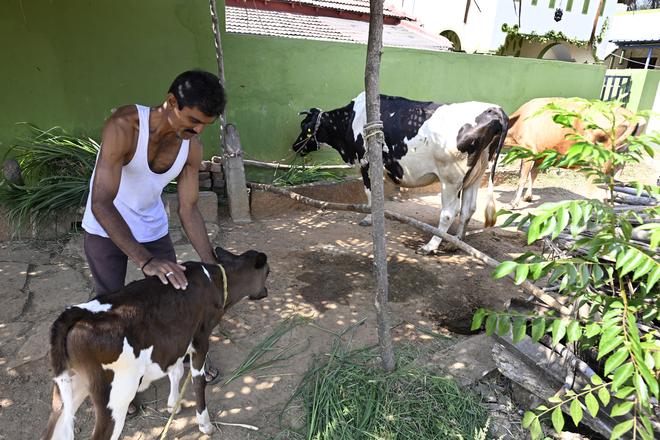Ravi., a dairy farmer in Keelara village in Mandya district in the heart of the Old Mysore region, has been able to earn a supplementary income from the cows that he rears and from the paddy he cultivates. However, the long spell of drought since last year forced him to sell two cows about six months ago because fodder has become difficult to procure.
He now has one cow to ensure milk supply to his own family and he is able to sell only a couple of extra litres to the local milk co-operative society. Though he has a borewell, the water yield has reduced so drastically that he cannot even grow green fodder. Purchasing fodder is out of the question because it is too expensive.
There are similar stories across Mandya, Kolar, Tumakuru, and Bengaluru Rural districts, which contribute the bulk of the Karnataka Milk Federation’s (KMF) milk procurement, along with Hassan, Mysuru, and Shivamogga districts in the State.
In Karnataka, about 24 lakh dairy farmers are members of village-level milk cooperative societies, and an unspecified number of non-members also rear cows in the State. The Old Mysuru region in south Karnataka has seen growth in milk production since the milk revolution started in the mid-70s. Affected by the vagaries of monsoon in rain-dependent arid and irrigated areas, dairy farming has brought supplementary income to the farming community, and women’s participation is also high.
The failed monsoon in 2023, which led to crop loss, has reduced post-harvest hay availability, while water scarcity has prevented farmers from growing green fodder, triggering a shortage of cow feed. Though the State government issued fodder kits containing seeds to farmers as a drought-mitigation measure, farmers complained that without water, the kit remained unused, and the green fodder wilted in many cases.
Karnataka is currently facing the worst drought in the last four decades, with 223 of the 236 taluks in the State being declared drought-hit. While the previous monsoon’s bountiful rainfall helped fill lakes and improve groundwater, which sustained farmers’ lives, the onset of summer has brought misery to rural households as a large number of water bodies and borewells have dried up or yielded less water.

Delay in incentive release
Added to their problem is the delay in releasing the government incentive of ₹5 per litre. The government released the last tranche in November 2023, and farmers were hoping to use the subsidy, which was expected later, to counter drought-related financial distress.
Since 2008, the State government has been providing incentives to dairy farmers, and the incentive has increased from ₹2 per litre when it was launched to ₹5 per litre now. The aid has helped draw more farmers to dairy farming, as milk procurement has more than doubled from 2008, when the average daily procurement was 36 lakh kg, to about 81 lakh kg by the end of the 2022-23 financial year.
While the government incentive does not have specific timelines for release, dairy farmers get their regular payment for milk from the KMF through their respective milk unions. Based on the financial strength of the union, the milk procurement price per litre also varies from district to district. This payment comes to farmers fortnightly through direct benefit transfers to their bank accounts.
“A 50 kg bag of dry feed sold by KMF costs ₹1,260. A tractor load of fodder can cost anywhere from ₹5,000 to ₹10,000. Only farmers who have fodder in excess are selling it. The government has delayed subsidy payments. Enough water and fodder are not available. To make matters worse, milk yield from cows has reduced because of heat,” Jayakumar, a farmer in Gejjalgere in Mandya, pointed out.

Drying borewells
In arid Kolar, where farmers are even more dependent on dairy farming to boost their income, the drying up of borewells — the only source of water — has added to the misery. A resident of Siddanahalli in Bangarpet of Kolar district, Thulasi Kumar, said he reduced the cattle head from four to two. “Extreme heat has led to low yield of milk from cows, and thereby a drop in income. While I was getting up to 13 litres of milk from a cow, it has dropped to less than 10 litres. I know of many who have reduced their cattle heads like me. On-time subsidy payment would have helped us,” he said.
Tumakuru, another district where dairy farming provides supplementary income, is no different. Dairy provided them with a steady source of income during any kind of distress. But that’s no longer the case because of scarcity of water and shortage of fodder. Many, like Jayanna, a resident of Belagarahalli in Tiptur, have kept just one cow to provide for only the family’s milk needs.
Those who have grown paddy or sugarcane with great difficulty, with water from the few functional borewells, are the ones who are left with hay, which is taking care of fodder needs. However, Panchalingu, a resident of Keregodu, said dry hay alone does not improve milk yield.
“I have hay from the paddy that I grew last year. However, hay does not help in increasing the milk yield. We are using a combination of hindi (local feed) made from grams, ragi, and other locally available proteins. Feed supplied by KMF has become expensive,” he complained. Farmers are selling cow dung to get as much additional income as possible though they will require dung as fertilisers for the coming monsoon, he added.
Dairy farmers like Lakshamma, a resident of Keelara, who do not have land to grow fodder, are dependent on stray fodder available in the village in open fields. But they have now dried up.
“Dairying is an important source of livelihood. I also work as a farm hand. It is difficult to maintain cows without having land. Buying fodder is not financially viable. I graze cows on the fringes of the village with whatever I get.” Lakshmamma has three cows, and she said she has asked her two sons to look after one cow each.

Low milk procurement
A 50-year-old, reasonably sized milk cooperative society in the temple town of Melukote, in Mandya district, has been recording low milk procurement since March end. From 14 cans of around 40 litres each, it has come down to eight or nine cans daily.
Those in the know about developments in the dairy industry say farmers began selling cows last year as dairying became unremunerative. One reason was the delay in increasing the procurement price.
KMF has been making multiple proposals to increase the retail price of milk since the BJP government. Finally, in July last year, the current Congress government allowed a hike in retail price by ₹3 per litre in July 2023, most of which is transferred to the farmers.
The BJP government was said to have delayed a price increase during an election year, fearing a backlash from the middle class. KMF sources said it was during that period that farmers resorted to selling cows because of increased input costs and dipping incomes. In July 2023, when the retail price was finally increased, the KMF had justified that despite the retail price hike, milk prices in Karnataka continued to be cheaper than in the neighbouring states.
In contrast to the farmers’ claim that the yield from their cows has reduced, the KMF sources say the total procurement across the State has actually increased over the last summer while the number of farmers supplying milk has remained almost the same.

KMF has over 24 lakh dairy farmer members across 14,000 milk cooperative societies in the State. According to KMF data, it makes a daily payment of over ₹17 crore. KMF is the second largest dairy cooperative in the country, and in South India, it stands first in terms of procurement as well as sales and milk-based products.
“In fact, we have seen over 4% growth. From 77.5 lakh litres of daily procurement, it has gone up to 82 lakh litres. Once the monsoon starts, we expect the total procurement to be around 95 lakh litres, though we hope to touch the one crore mark.”
Dues from previous govt.
KMF sources said they are saddled with arrears. “Dues to the tune of ₹450 crore remains from the previous BJP government. There is also ₹212 crore pending. Both of which add up to about ₹700 crore. This money was given to the farmers in the previous financial year.”
Sources cited the election as the reason for the delay. The government released ₹260 crore earlier this week, while ₹700 crore (of the latest tranche) is still pending and will be released in the next quarter.
(With additional inputs by Jahnavi T.R.)







